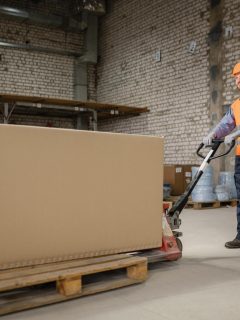Inefficiencies can occur at every stage of logistics – and the packaging process is no exception. However, the Lean approach, primarily known from manufacturing, also offers a great framework for packaging optimization. The goal is single: to eliminate waste (time, motion, material) and increase value for the customer.
🔍 What is waste from a lean perspective?
The lean approach defines 7 types of waste (called muda) that can be easily transferred to packaging processes:
-
Unnecessary movement – e.g. commuting for materials, re-handling or frequent turning at the table.
-
Unnecessary transport – moving goods between workplaces without adding value.
-
Waiting – for colleagues, materials, label printing, etc.
-
Overstocking – too much filler material or boxes in stock.
-
Overproduction – e.g. pre-packing shipments without a confirmed order.
-
Unnecessary processes – duplicate steps, such as repeated measuring or inspection.
-
Errors and corrections – damaged shipments, overpacking due to inappropriate packing size.
✅ How to implement lean in the packaging process?
1. Packaging standardisation
Establish clear procedures for each type of goods – what to pack, how and in what. Create simple work instructions with visual elements (photos, pictograms). This will reduce both error rates and training time for new employees.
2. Ergonomic packing station
Workstation layout has a major impact on productivity. All materials should be within arm’s reach, without the need to browse or stretch unnecessarily. Adjustable table heights or dispensing systems for fillers can help.
3. The 5S system for order and clarity
The 5S (Seiri, Seiton, Seiso, Seiketsu, Shitsuke) methodology leads to sustainable order:
-
Sort the useless
-
Organize necessary tools logically
-
Clean the workplace regularly
-
Standardize the layout
-
Maintain habits
4. Visualization and marking
Clear identification of box sizes, fillers, labels and tools speeds up work and reduces confusion. Colored labels, label trays, pictograms or color-coded zones are ideal.
5. Elimination of redundant movements
Map the packaging process and identify unnecessary steps. Simple layout analyses can help – sometimes you just need to move a roll of film closer to the table or merge two activities.
6. Measurement and improvement (Kaizen)
Without measurement, there is no improvement. Track packing time, defect rate, or consumption of filler materials. Involve employees – they will often suggest effective changes themselves.
🎯 The result is faster and more efficient packaging
Implementing lean principles into packaging processes doesn’t mean big investments, but rather smart changes. The result is not only cost savings, but also less stress in the workplace, fewer mistakes and higher customer satisfaction.
At RAJA, we believe that a well-adjusted packaging process starts with simple improvements. We are happy to advise you on how to optimise your packaging workplace with the right equipment and methodology.














